Miscellaneous Blogs
Book Review: Diving Gozo & Comino – The essential guide to an underwater playground
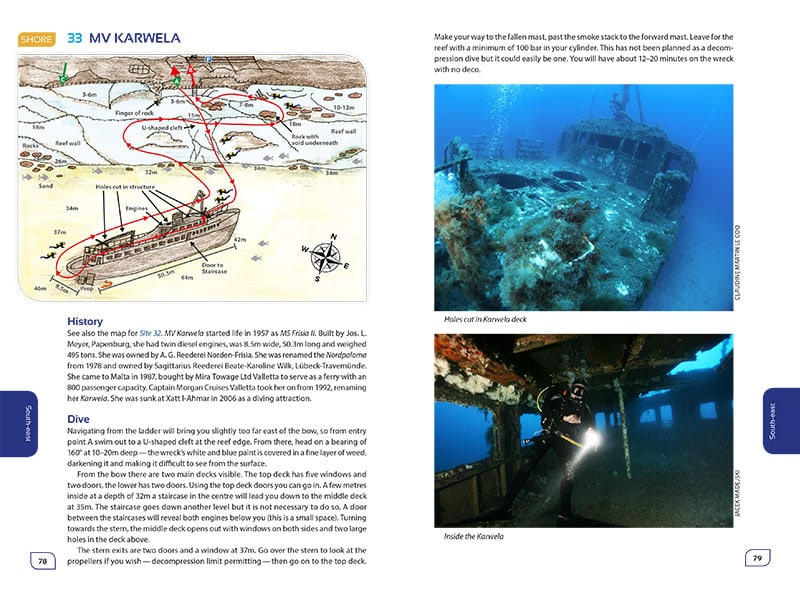
The Author
Richard Salter
Review by Nick and Caroline Robertson-Brown
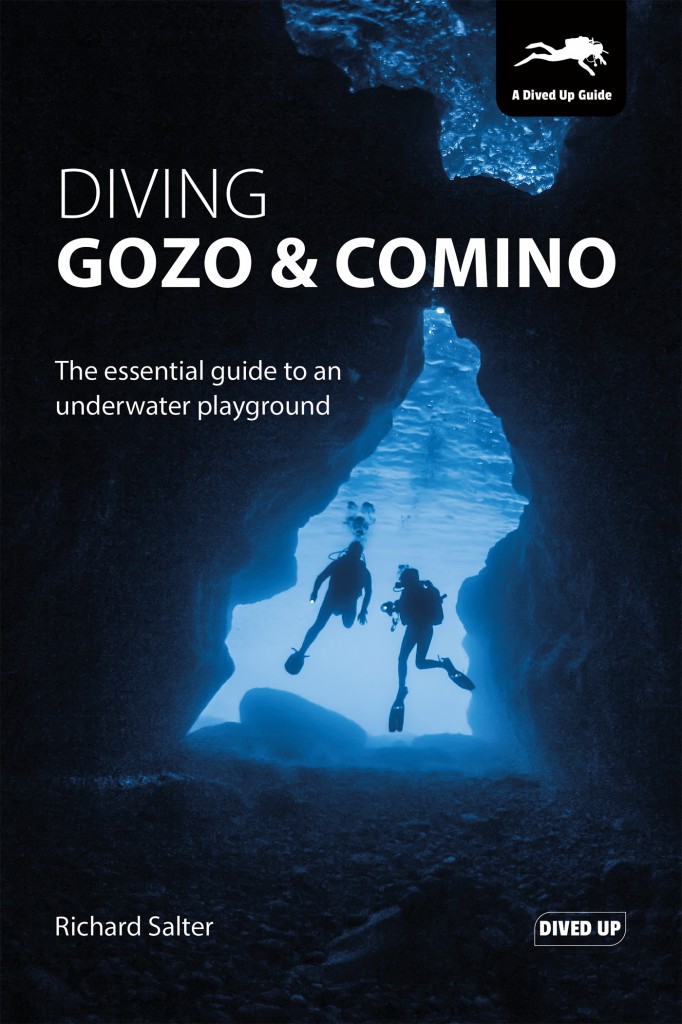 First impressions of this book are good. It has lovely inviting front and back covers and is the right size to take on a trip with you. It is a paperback book, keeping the weight down for travel, but still uses high quality paper. Now, we have never dived Gozo or Comino, so are not going to be able to argue the accuracy of the dive site descriptions, but Richard is an instructor and guide on the island with masses of experience. The book had just gone to press when the famous Azure Window collapsed, and so some edits had to be made to correct this information, but it now has up to date information about diving this area.
First impressions of this book are good. It has lovely inviting front and back covers and is the right size to take on a trip with you. It is a paperback book, keeping the weight down for travel, but still uses high quality paper. Now, we have never dived Gozo or Comino, so are not going to be able to argue the accuracy of the dive site descriptions, but Richard is an instructor and guide on the island with masses of experience. The book had just gone to press when the famous Azure Window collapsed, and so some edits had to be made to correct this information, but it now has up to date information about diving this area.
The book covers 57 dive sites on Gozo and a further 14 on Comino, featuring both shore and boat dives that include caves, caverns, ship wrecks, reefs and sheltered bays. The first few pages cover some essential information about diving these islands, some history, useful phrases and where to visit when you are not underwater. Then the book gets into the nitty gritty of the dive sites themselves.
Most of the dive site descriptions include a detailed map, with a suggested route drawn on to assist those that will be diving without a guide. There is a written description of the dive and a useful details box to give depth, duration, visibility and difficulty level, as well as including tips like taking a torch on dives that have overhead environments, or to use an SMB in heavy boat traffic areas. There is usually a photo or two taken above water to show the topography and entry points for the dive site, and there are underwater photographs too. I would have liked to see more quality underwater photographs to show off the diving here and to whet my appetite.
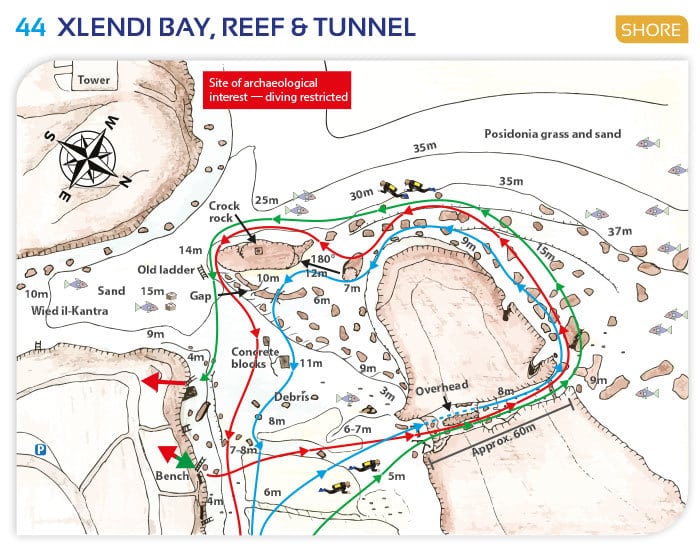
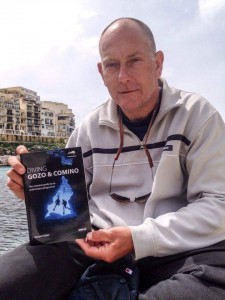
Richard Salter
I was very pleased to see a section at the back about seahorse photography and their strict protection on these islands and there are additional pages on invasive species and seagrasses too. There is also a handy list of dive centres, emergency contact details and a wealth of other useful titbits that raise this publication above the standard dive guide. I was surprised to see the odd advert in the book though, but I guess a book like this might need a little extra funding to help publishing costs.
All in all, this is a well put together and good-looking guide book that will be a useful tool for anyone planning on diving Gozo and Comino. It is the sort of book that first timers, as well as those experienced in diving here, will want to have on their shelves… I would certainly love to put it to the test and dive some of the sites using the book as a guide.
Available now in paperback (ebook forthcoming) from Divedup.com, online and from retailers.
£16.95 / €19.95 / US $24.95 | ISBN 978-1-909455-16-0 | 176 pages | 234 x 156 mm
Scubaverse.com is currently running a competition where you can win a copy of ‘Diving Gozo & Comino – The essential guide to an underwater playground’. The competition ends at midnight next Tuesday 6th June. You can enter the competition to win a copy of Richard’s book here.
Blogs
RAID: The Globally Respected Agency


If you ever wondered what’s the exciting buzz around the RAID Diver Agency, we can tell you right here!
The prestigious Royal Thai Marine Police have chosen RAID as their trusted agency for their Underwater Operations Course.

This intense and rigorous course is designed to equip the force with the specialized skills and expertise needed for all underwater operations, ensuring they are totally prepared for the challenges of their critical missions.
With RAID‘s comprehensive training, the Royal Thai Marine Police will be well-prepared to handle the demands of their underwater tasks.


Why RAID? Truly Different?
The RAID philosophy is we are divers, not Recreational or Technical, just divers.
We all start with our first breath underwater with limited knowledge and experience. How much theoretical knowledge individuals may want is a personal choice.
However, when it comes to practical experience, there should be no difference to the required skill foundation and learning the fundamentals of diving is crucial.
With the roots of RAID International being founded in a technical background, the ethos is to provide all divers with solid fundamental skills of diving buoyancy, hover & trim which provide a robust platform for any future training in whatever direction they decides interests them.
How do RAID do that?
RAID conduct all dive skill training how you would use it practically. Perfect buoyancy with good hover and trim position.

Other agencies teach you to sit on the bottom and do skills! Do you go to the bottom every time you want to clear your mask?


Dive training in a class of its own.
RAID FREe-Learning.
No smoke and mirrors with RAID, there is nothing to hide.
Everyone can access any and all of RAID course theory and skills manuals online and downloadable without any charge or commitment.
Truly FREe-Learning
You bet that wasn’t popular with the book selling agencies!
If that wasn’t enough, additionally, all the skills videos, are available on YouTube with FREE access.
The core of RAID‘s ethos is to provide all divers with solid fundamental skills of diving buoyancy with perfect hover & trim providing a robust platform for any future training.
To enable that, RAID Professionals must have skills honed to the highest level, always performed with consummate ease and completely naturally.
 To access the whole FREe-Learning library completely without any commitment or cost, simply register with RAID by scanning the QR code.
To access the whole FREe-Learning library completely without any commitment or cost, simply register with RAID by scanning the QR code.
No one will contact you, you are free to download and peruse whatever you want to.
Should you decide you would like to know more or would like to take a course contact James at RAID UK and he will direct you to your local RAID centre.
RAID UK
James Rogers
www.diveraiduk.com
info@diveraiduk.com
+44 191 4324644
RAID – A Global Agency
RAID has Regional Offices around the world all fully embedded in the governing bodies of diver training.
WRSTC Member USA, ERSTC Member EU, Worldwide ISO Certified, RTC founding member.
RAID Dive Centres are in all corners of the UK!
All ready to offer divers and beginners a friendly welcoming new standard of service. Whether you are ready to take your first breath or an experienced exploration diver, make visiting a RAID Dive Centre your next step.
Here are just a few suggestions.

Bay Divers
Swansea
www.baydivers.co.uk
+44-7859-018970


 West Coast Diving
West Coast Diving
Kilmarnock
www.westcoastdiving.co.uk
+44-7904-539512


 SevernTec Diving
SevernTec Diving






RAID – Holiday Destinations
Looking to take a dive trip with your club or personally, here are just a few popular RAID dive holiday destination ideas for the UK based diver.
Egypt
Maldives
Bali
Thailand
South Africa
Click to contact the Regional Office for a full list of dive destinations in that region.
EGYPT




 Pharaoh Dive Club
Pharaoh Dive Club
Roots Red Sea, El Quseir, Egypt
info@pharaohdiveclub.com
www.pharaohdiveclub.com
+20 10068 22000
Multi award winning centre offering special ‘Dive & Stay’ packages


 Scuba Dreamer Diving College
Scuba Dreamer Diving College
Park Regency, Sharm El Sheikh, Egypt
www.scubadreamer.it
info@scubadreamer.it
+20 122 7150550
Based at Park Regency & Beach Promenade providing a full 5* package


MALDIVES



Fehivina Dhangethi &
Dhodhi – Dhiffushi – North Male’ Atoll
www.scubadivinemaldives.com
scubadivinedhangethi@gmail.com
scubadivinedhiffushi@gmail.com
+96 07913075
Range of accommodation options available


 Jerrys Dive Club
Jerrys Dive Club
Rasdhoo, Maldives
www.jerrysdiveclub.com
hello@jerrysdiveclub.com
+960 772 7876
Stay at Jerry’s Guest House


BALI



Prana Dive
Kabupaten Karaangasem, Bali, Indonesia
www.pranadive.com
info@pranadive.com
+62 813 3877 5345
Why not stay with us at Teratai Boutique Resort


THAILAND






SOUTH AFRICA


 Adventure Mania
Adventure Mania
Sodwana Bay, South Africa
www.adventuremania.co.za
info@adventuremania.co.za
+27 82 653 7824
Adventure Mania takes pride in providing personalised, eco-conscious dives that highlight the beauty of protected coral reefs and marine life. This family diving business, nestled within a Marine Protected Area, offers a diving experience that is as educational as it is exhilarating.
Adventure Mania’s expert instructors and staff have a deep-rooted passion for ocean conservation. They not only guide divers through breathtaking underwater landscapes but emphasise the importance of marine preservation. Teaching diving with Adventure Mania goes beyond imparting technical skills; it embraces fostering a respect for the ocean.



ScubaCo
Durban, South Africa
www.scubaco.co.za
info@scubaco.co.za
+27 79 779 4242
ScubaCo is a boutique RAID Dive Centre operating on the Kwa-Zulu Natal coastline of South Africa. ScubaCo are specialists in both shark and reef diving as well as featuring the annual Sardine Run migration as they are so well positioned to offer the best of the best.
Many clients enjoy our wonderful packages with ScubaCo Guest House accommodation coupled to amazing dive options – Shark Diving, Big 5 Safari & Diving the Sardine Run.
This destination is a must for every Diver and should be on your bucket list for dive travel.
Make sure to add Aliwal Shoal to your next Diving holiday and let Tamara and her team take fantastic care of you while in South Africa.


Dive & Travel the RAID way
When you see the RAID emblem at a dive centre around the world you can be assured that the highest standards of diver training are being provided, knowing all RAID professionals have met the testing criteria to achieve their professional rank.

Blogs
The BiG Scuba Podcast Episode 180: Dawn Kernagis
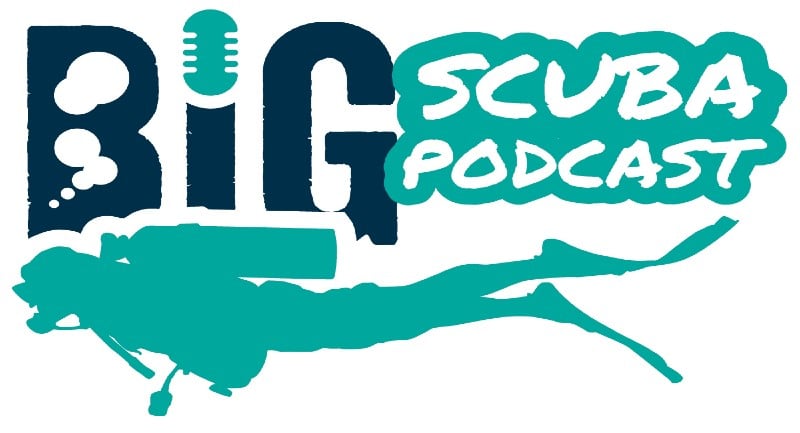
Gemma and Ian chat to Dawn Kernagis. Dawn joined DEEP in 2023 as the Director of Scientific Research. DEEP is an ocean technology and exploration company with a mission to ‘Make Humans Aquatic.’ DEEP’s undersea habitat and submersible systems, combined with multi-phased diver and human performance training, will create the next evolution of subsea science, research, and exploration capabilities. Dawn is a NASA-trained NEEMO Aquanaut, Explorer’s Club Fellow and Women Divers Hall of Fame Inductee and who is also tasked to establish DEEP’s first US presence in North Carolina. Dawn has also been a diver with numerous underwater exploration, research, and conservation projects since 1993, including the mapping and record-setting exploration of some of the deepest underwater caves in the world.
https://www.linkedin.com/in/dawn-kernagis-995383152/
The BiG Scuba Podcast is brought to you by Narked at 90. “Beyond Technical” Narked at 90 If you are thinking of moving across to tech diving or completely new to diving, Narked at 90 can advise and guide on the best equipment and set up for your personal or commercial requirements https://www.narkedat90.com/. There is currently a code for you to use for purchases and the code is BIGSCUBA2024.
If you are interested in the INSTA360 action camera we discussed then please click this link: https://www.insta360.com/sal/x3?utm_term=INRAI8S
We hope you have enjoyed this episode of The BiG Scuba Podcast. Please give us ★★★★★, leave a review, and tell your friends. Contact Gemma and Ian with your messages, ideas and feedback via The BiG Scuba Bat Phone +44 7810 005924 or use our social media platforms. To keep up to date with the latest news, follow us:
We are on Instagram @thebigscuba
We are on Facebook @thebigscuba
We are in LinkedIn https://www.linkedin.com/in/ian%F0%9F%A6%88-last-325b101b7/
The BiG Scuba Website www.thebigscuba.com
Amazon Store : https://www.amazon.co.uk/shop/thebigscuba
Visit https://www.patreon.com/thebigscubapodcast and subscribe – Super quick and easy to do and it makes a massive difference. Thank you.
🎧You can listen to the BiG Scuba Podcast on all major podcast platforms including …. iTunes, SoundCloud, Spotify and Stitcher 😀. ISSN Number 2752-6127
-

 Blogs2 months ago
Blogs2 months agoDiving With… Nico, Ocean Earth Travels, Indonesia
-

 News1 month ago
News1 month agoMurex Bangka Announce New Oceanfront Cottages & Beachfront Dining
-

 Blogs2 months ago
Blogs2 months agoA new idea in freediving from RAID
-

 Marine Life & Conservation1 month ago
Marine Life & Conservation1 month agoIceland issue millionaire whale hunter a licence to murder 128 vulnerable fin whales
-

 Marine Life & Conservation2 months ago
Marine Life & Conservation2 months agoThe Shark Trust Great Shark Snapshot is back
-

 News3 months ago
News3 months agoCharting New Waters; NovoScuba Goes Global with the Launch of their Revolutionary Dive Training Agency!
-

 Gear News1 month ago
Gear News1 month agoNew Suunto Ocean – a dive computer and GPS sports watch in one for adventures below and above the surface
-

 Marine Life & Conservation Blogs2 months ago
Marine Life & Conservation Blogs2 months agoBook Review: Plankton















 Dive South
Dive South